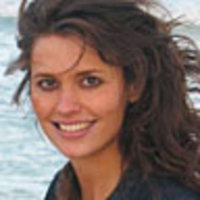Just as climate change has won its place on the mainstream political agenda, it seems apt, too, that eco-aware artists should now be inside, quite literally, the academy. From degree shows to art fairs, artists have shown that they have the agenda of the anarchic Plane Stupid campaigners. Now, with 35 works from established and emerging artists, showing in Earth—Art of a Changing World, they are gathered in the Royal Academy, (founded 1768 by George III), once the official arbiter of British tastes.
At this week’s Turner Prize ceremony at Tate Britain, traditionally the gauge of contemporary art in Britain, climate change was high on the agenda as well. Lisson director Nicholas Logsdail was even wearing a slightly sinister black and white arm band, with the single word NO. "It means whatever you want it to," he explained. "No to war, no to climate change, and no to not saying no to anything … which we see a lot of these days too." The piece is part of a global installation by Santiago Sierra.
Click Image to View Our Gallery of Earth: Art of a Changing World

With climate change, though, artists are saying no, in vibrant form—particularly Turner Prize-winner Richard Wright, a 49-year-old London artist, who is represented by Larry Gagosian, despite the fact that it’s hard to put a price on his works. Their lifespan is as threatened as the planet.
Using the techniques of medieval illuminators, Wright paints directly onto the walls. For the current Turner exhibit, Wright has worked seductively in gold leaf. When the show ends next year, his elaborate, intricate wall, into which the mind’s eye leaps to explore, will be painted over. If his beauty is brutal, it’s beautifully timely, too.
That sense of fragility is a dominant note in the RA’s show, too. Just as man blunders through the planet, Clare Twomey’s brittle flowers may not last the course of the show. A note says that they are "subject to the impact of visitors to the gallery." Enough said. Her flowers are the piece Specimen—sterile, clinical white, and cold to the touch. Their deathly perfection offers an eerie suggestion that flowers could one day belong in museums and the way she’s scattered them throughout the gallery, on shelves, and on the fireplace, has grownup visitors reaching out to clumsily prod, and wonder if they are part of the exhibition.
There’s a similar conceit in Danish artist Tue Greenfort’s Medusa Swar, which dangles all-too-perfectly-pink glass jellyfish against the blank white walls of the gallery. To add to the sense of natural beauty as a luxury item, they aren’t just any old glass, but Murano. (It’s perhaps not fanciful to see that touch as an allusion to Venice, another, vulnerable beauty.)
Some of the most striking works, however, have not been made for this show. There are several personal (step forward, Tracey Emin) or political works here given a more ecological interpretation. Amazonian Field, by Antony Gormley, is one particularly evocative example. Where once his little earthen figures seemed to be about a specific geographical issues of overpopulation (The Third World versus a Luckier World), now his little creatures seem like every-clay-men. Similarly in this context, Mona Hatoum’s Hot Spot, which depicts the globe as a grid of red-hot molten boundaries, presents the whole world as a vulnerable point, liable to explode. This time, however, we are all in the firing line for environmental reasons.
My favorite piece is a triptrych of videos by Finnish artist Antti Laitinen, It’s My Island. The artist filmed himself in the Baltic Sea desperately struggling against the waves, building the island with rocks, like a hopeless dam. The idea of no man being an island, and King Cnut, echo. That sense of futility though isn’t the dominant note, though. The exhibition is organized by the Royal Academy and Cape Farewell, the presciently titled Arctic research and expedition program. Cape Farewell founder, artist David Buckland, co-curated this show. Founded in 2001, Cape Farewell invites artists and writers out to one of the most beautiful and most vulnerable areas of the Arctic. Buckland believes passionately in using great cultural communicators to get the message out.
At opening of the RA exhibition, some of his key recruits—from Gormley to novelist Ian McEwan—were gathered. Buckland had often issued the invitation to the furthermost tip of the Arctic. “To start with, [McEwan] wasn’t sure that he could use the experience in a novel” he recalled. By 2005, he had changed his mind and Solar, his novel to be published this spring, is partly the result. It centers on a physicist who finds himself enduring trial by media for his research. “I’m waiting to see what character he’s based on me,” joked Buckland.
An extract titled “The Hot Breath of Our Civilisation,” in the cool, detached form of the red electronic fonts of train or airport announcements, or financial markets, reels across a screen in the final room of the Earth show. “We resemble a successful lichen, a ravaging bloom of algae, a mold enveloping a fruit,” reads the text.
As the Copenhagen delegates arrive, his words could not seem more timely: “We are a clever but quarrelsome species—in our public debates we can sound like a rookery in full throat. We are superstitious, hierarchical, and self-interested, just when the moment requires us to be rational, even-handed, and altruistic.”
Time, always one of McEwan’s shibboleths, is of course the great elastic theme at the center of climate-change debate: “Are we at the beginning of an unprecedented era of international co-operation, or are we living in an Edwardian summer of reckless denial? Is this the beginning, or the beginning of the end?”
What science cannot tell us, perhaps art can.
Plus: Check out Art Beast for galleries, interviews with artists, and photos from the hottest parties.
Olivia Cole writes for the Spectator and the London Evening Standard. An award-winning poet, her first collection, Restricted View , was recently published by Salt Publishing.



